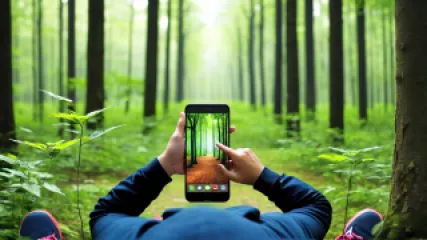Mastering Digital Wellness: A Step-by-Step Guide
Mastering Digital Wellness: A Step-by-Step Guide
In today's increasingly digital world, maintaining a healthy relationship with technology has become paramount. Overwhelmed by the constant barrage of notifications, social media scrolling, and the temptation to stay constantly connected, many individuals struggle to find a balance between the benefits and drawbacks of our tech-driven lives. However, with the right strategies and a proactive approach, it is possible to achieve digital wellness and reclaim control over your digital experiences.
In this comprehensive guide, we will explore a step-by-step approach to mastering digital wellness. From understanding the impact of technology on our physical and mental well-being to implementing practical techniques for better tech habits, this tutorial will equip you with the tools and knowledge necessary to cultivate a healthier, more intentional relationship with the digital world.
Recognizing the Impact of Technology on Well-Being
The ubiquity of technology in our daily lives has transformed the way we work, communicate, and engage with the world around us. While digital advancements have undoubtedly brought many conveniences and opportunities, the constant exposure to screens, notifications, and digital stimuli can also have significant implications on our physical, mental, and emotional well-being.
Physical Impact: Prolonged use of digital devices can lead to a range of physical ailments, such as eye strain, headaches, neck and back pain, and disrupted sleep patterns. Sedentary lifestyles fueled by excessive screen time can also contribute to obesity, cardiovascular issues, and a general decline in physical health.
Mental and Emotional Impact: The constant stimulation and distractions of digital technologies can have a detrimental effect on our mental health. Excessive social media use, for example, has been linked to increased feelings of anxiety, depression, and low self-esteem. The fear of missing out (FOMO) and constant comparison to idealized online personas can also contribute to heightened stress and a diminished sense of well-being.
Cognitive Impact: The multitasking nature of digital devices and the constant availability of information can also impact our cognitive abilities. Research has shown that constant digital distractions can lead to decreased attention spans, impaired memory, and reduced productivity.
Recognizing the potential negative impacts of technology on our well-being is the first step toward developing a healthier relationship with digital tools and cultivating digital wellness.
Establishing Digital Boundaries
One of the key strategies for achieving digital wellness is setting clear boundaries and limits around our technology use. This involves consciously allocating time and attention to digital activities, while also creating spaces and moments of digital detachment.
Set Specific Tech-Free Zones and Times
Designate certain areas of your home, such as the bedroom or dining room, as tech-free zones where digital devices are not permitted. Additionally, establish tech-free times, such as during meals or before bedtime, to create a sense of digital respite and facilitate more mindful, present-focused interactions.
Implement Digital Detox Periods
Regularly engaging in digital detox periods, whether it's a few hours a day, a day per week, or even a more extended digital-free vacation, can be incredibly beneficial for your well-being. During these detox periods, focus on engaging in non-digital activities, such as reading, exercising, or spending time in nature, to recharge and reconnect with the physical world.
Limit Screen Time and Notification Overload
Be mindful of the time you spend on digital devices and the number of notifications you receive. Utilize built-in screen time tracking and limitation features on your devices to set daily or weekly limits, and consider turning off unnecessary notifications to reduce digital distractions and interruptions.
Cultivate Mindful Technology Use
Approach your digital interactions with intentionality and presence. Before reaching for your device, pause and ask yourself if the action is truly necessary or if it can wait. Engage with digital content and applications with a heightened sense of awareness, avoiding the tendency to mindlessly scroll or multitask.
By establishing clear boundaries and cultivating mindful technology use, you can reclaim control over your digital experiences and create a healthier, more balanced relationship with technology.
Optimizing Digital Habits and Routines
Developing healthy digital habits and routines is crucial for maintaining long-term digital wellness. This involves proactively shaping your digital environment and practices to support your well-being.
Curate Your Digital Environment
Take an active role in curating the digital content and applications you engage with. Unsubscribe from unnecessary email lists, mute or unfollow social media accounts that trigger negative emotions, and prioritize digital tools and platforms that align with your values and goals.
Streamline Your Digital Workflows
Identify and address any inefficiencies or time-wasting habits in your digital workflows. Implement productivity-enhancing strategies, such as using keyboard shortcuts, organizing your digital files and folders, and leveraging productivity apps and tools to automate repetitive tasks.
Prioritize Digital Decluttering
Regularly declutter and organize your digital spaces, such as your computer's desktop, email inbox, and cloud storage. Removing unnecessary files, emails, and digital clutter can help reduce cognitive load and create a more visually and mentally calming digital environment.
Cultivate Digital Mindfulness
Approach your digital interactions with a greater sense of mindfulness and presence. When using digital devices, be aware of your physical posture, breathing, and emotional state. Regularly take breaks to stretch, walk, or engage in other mindfulness practices to counteract the effects of prolonged digital engagement.
Establish Healthy Digital Routines
Develop consistent digital routines that support your overall well-being. This might include setting aside dedicated time for focused work, implementing digital wind-down rituals before bedtime, or incorporating regular digital-free activities into your daily schedule.
By optimizing your digital habits and routines, you can create a more intentional and harmonious relationship with technology, ultimately enhancing your overall well-being.
Harnessing the Benefits of Digital Tools
While it's essential to establish boundaries and cultivate healthy digital habits, it's also important to recognize the potential benefits of technology and leverage digital tools to support your well-being.
Embrace Productivity-Enhancing Apps
Utilize productivity-focused apps and tools to streamline your workflows, manage your time more effectively, and minimize distractions. Examples include task management apps, time-tracking software, and focus-enhancing browser extensions.
Leverage Wellness-Oriented Technologies
Explore digital tools and applications designed to support your physical, mental, and emotional well-being. This might include fitness and mindfulness apps, digital journaling platforms, or online therapy and coaching services.
Foster Meaningful Connections
While excessive social media use can be detrimental, digital tools can also facilitate meaningful connections and support systems. Engage with online communities, join virtual support groups, or leverage video conferencing to maintain long-distance relationships and cultivate a sense of social belonging.
Harness the Power of Digital Learning
The digital landscape offers abundant opportunities for continuous learning and personal growth. Explore online courses, educational platforms, and digital resources to expand your knowledge, develop new skills, and support your lifelong learning journey.
By selectively harnessing the benefits of digital tools and technologies, you can leverage the advantages of the digital world while maintaining a balanced and healthy relationship with technology.
Maintaining Digital Well-Being During Challenging Times
The COVID-19 pandemic has significantly accelerated our reliance on digital technologies, creating both opportunities and challenges for maintaining digital well-being. As many aspects of our lives have shifted online, it's crucial to adapt our digital wellness strategies to address the unique circumstances we face.
Navigating Remote Work and Learning
With the rise of remote work and distance learning, it's essential to establish clear boundaries and routines to prevent digital fatigue and burnout. This might involve designating dedicated workspaces, scheduling regular breaks, and setting expectations around availability and response times.
Fostering Social Connections Virtually
While in-person social interactions may be limited, it's vital to find ways to maintain meaningful connections with friends, family, and communities through digital platforms. Organize virtual social gatherings, participate in online support groups, and embrace the potential of video calls to nurture your relationships.
Prioritizing Self-Care in the Digital Realm
During challenging times, it's even more important to prioritize self-care and digital well-being. Incorporate digital wellness practices, such as mindfulness exercises, digital detox periods, and technology-free relaxation routines, to support your physical and mental health.
Navigating the Influx of Digital Information
The pandemic has led to an unprecedented influx of digital information, from news updates to health guidance. It's crucial to be discerning in your consumption of digital content, relying on trusted sources and fact-checking information to avoid information overload and anxiety.
By adapting your digital wellness strategies to the unique demands of the current environment, you can cultivate a sense of balance, resilience, and well-being amidst the ongoing digital transformation of our lives.
Cultivating a Holistic Approach to Digital Wellness
Mastering digital wellness is not a one-size-fits-all approach, but rather a holistic and personalized journey. The strategies and techniques outlined in this guide should be considered starting points, which you can then tailor and refine to suit your unique needs, lifestyle, and goals.
Remember, digital wellness is not about completely eliminating technology from your life, but rather about striking a healthy balance and cultivating a more intentional relationship with digital tools and experiences. It's about recognizing the impact of technology on your well-being and proactively shaping your digital landscape to support your overall health and fulfillment.
As you embark on this journey, be patient, adaptable, and open to experimentation. What works for one person may not work for another, so be willing to try different approaches and continuously refine your digital wellness practices. Celebrate your successes, learn from your challenges, and embrace the ongoing process of mastering digital wellness.
By prioritizing your digital well-being and adopting a holistic approach to technology usage, you can unlock the incredible potential of the digital world while maintaining a vibrant, healthy, and balanced lifestyle. Embrace this journey, and unlock the transformative power of digital wellness in your life.






